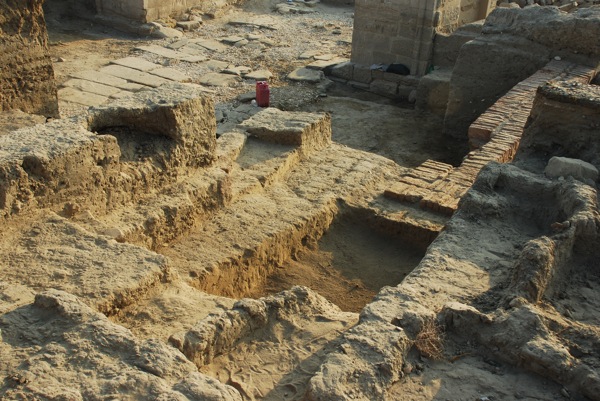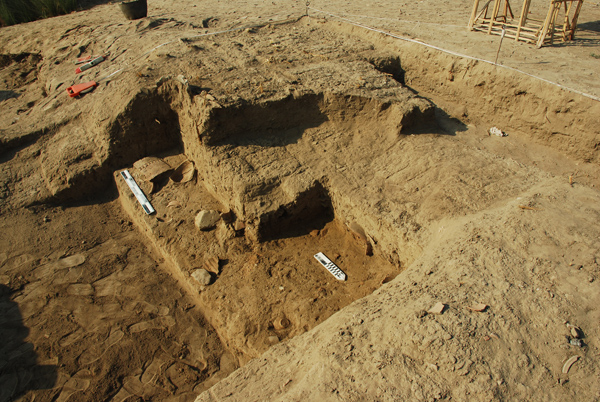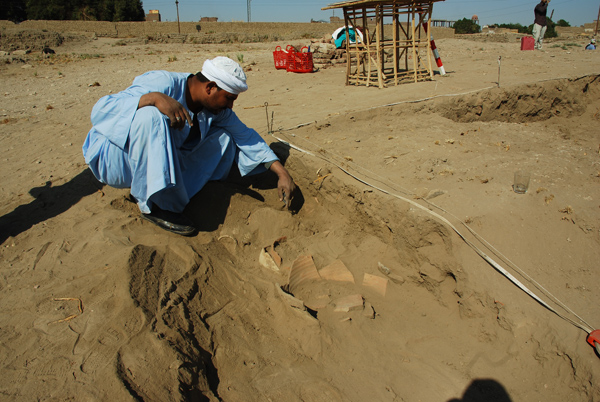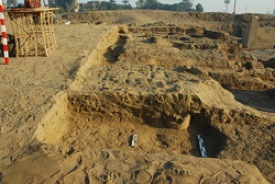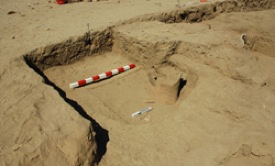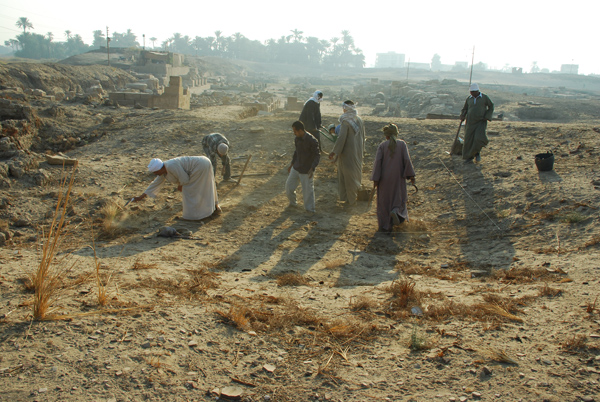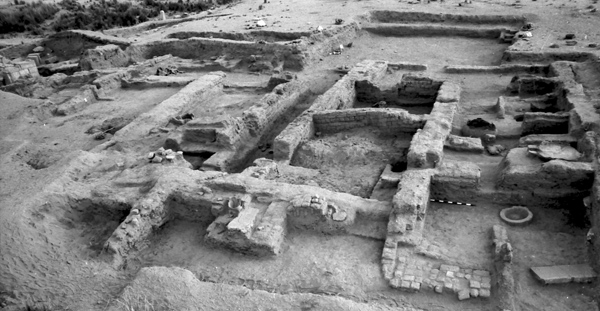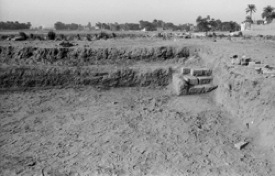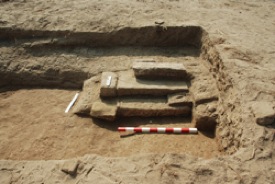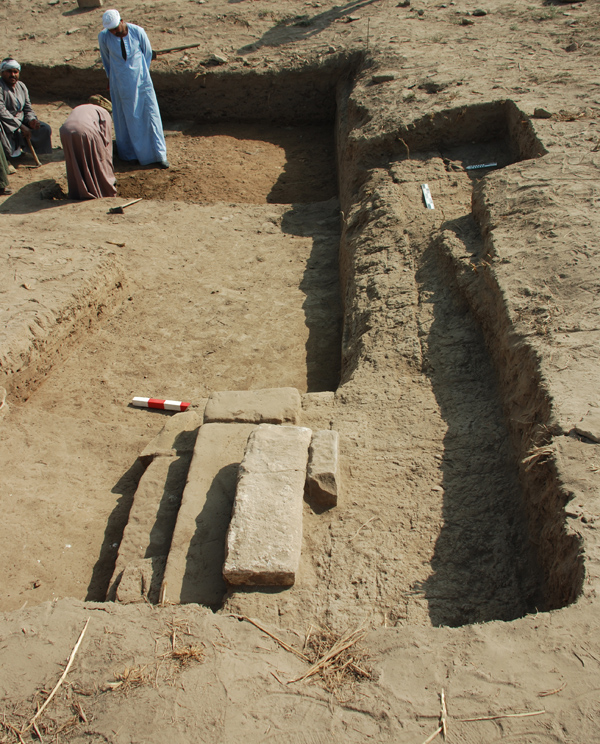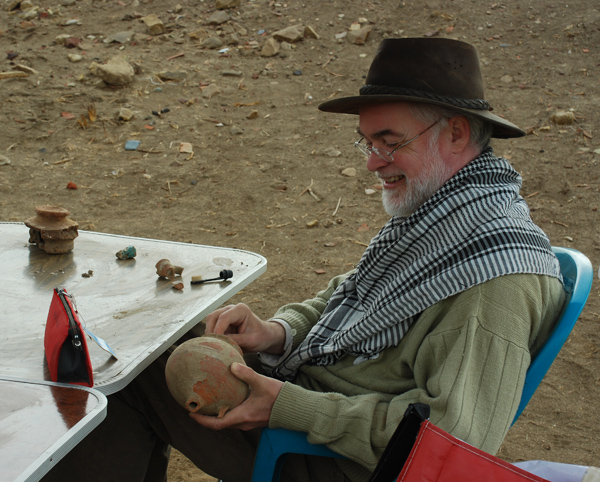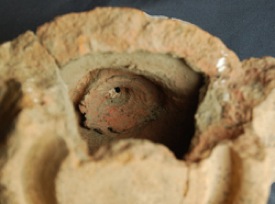The Second Week
On January 15 we finished removing the baulk stub over the remains of the southern boundary wall of the Taharqa Gate approach. In this view to the northeast, you can now see that we have a single, wide wall that has been successively cut back. All that remains now is to map this new section of the wall.
The last of the pottery spill found in the angle of the walls at the south end of the excavation area. The sherds to the right of the meter stick sit in a corner formed by the north face of the Tuthmoside enclosure wall and the new wall found last week. With the pottery removed, we decided to explore slightly further south to see if the mud brick continues further south.
It doesn’t. Just south of our baulk line Abdel Aziz found that the mud brick gives way to loose soil containing a lot of pottery, including the broken round jars just in front of him.
One of the pieces of pottery was this storage container that projected from below the mud brick – or seemed to (left). Further cleaning revealed that the jar actually sits in front of the wall, which was built on top of the Tuthmoside enclosure wall. The jar is set in a square void in the enclosure wall, its south and west edges visible in the photo to the right. Once we’ve mapped the area we will remove the storage jar, the last part of the work here.
Having now answered two of the questions we set out to resolve in this short season, I decided on the 16th to open a new square west of the Taharqa Gate to try to answer a third question: does the pavement running west from the Taharqa Gate continue the curve to the south that is apparent in the area excavated in 2010? Since our time is limited, the most sensible area for this square was an area we had last worked in 1978, seen here today looking east.
The same square is in the background in the photo taken from the enclosure wall at the end of the 1978 season. It is part of a group of late Ptolemaic and early Roman Period habitations we had found built north and west of the Taharqa Gate. The area we are re-opening is an open courtyard with a 3-step stairway in its southwest corner. We also want to find out this year if the wall along the south side of the court is a continuation of the south boundary wall of the approach to the Taharqa Gate.
On the left are the steps as they were in 1978, with a border of mud brick along the east side; on the right as they are today. In clearing them again we uncovered the mud brick border along the stairs’ west side, which had been buried under the 1978 baulk. By re-excavating the stairway and its associated surface we should be able to link the surface of the courtyard (and hence the houses to its north) to any structures or features uncovered this season.
In this view east, taken late Thursday morning, you can see that the courtyard’s wall runs the full length of the square with the stairway at its west end (foreground). The section across the wall (middle) revealed its south face, with another building abutting it directly. While the area of the stairs was being worked on, we temporarily divided the excavation area to make it easier for everyone to get around. In the deepest part reached so far (background), we have come on a surface with a heavy concentration of mostly small pot sherds. We’re curious to see how far this level extends.
Jaap van Dijk, of the State University of Groningen, was able to join us again, briefly, this season. It’s always good to have him back. Not only is he fun, but he’s a terrific object registrar. Here he is cleaning a rather nice juglet Abdel Aziz found among the pots atop the Tuthmoside wall. On the table in front of him is what we have dubbed the mystery object.
This strange, hollow object came from the loose surface in the courtyard square. We have no idea what it is. We are assuming that the side with the double ring base (left) is the bottom as the object sits most securely on it. The small hole in the top (right) is intentional. What is left of the rim of the “top” and the shape of the painted band suggests the upper section may have been somewhat oval in shape.
The object is made up of 2 separate elements that were joined together before firing. Inside, the areas around the center point of both the top (shown here) and bottom have been carefully finished. As you can see in the profile (right), the rim or collar where the two sections join is almost as thick as each section. It might be a lamp, based on the possibly ovoid shape of the upper part that might have accommodated a spout, but the hole in the top is too small to be used to fill a lamp. Or perhaps it’s an incense burner, with the small hole being where the scented smoke escapes. The only problem is, there doesn’t seem to be any burning on the inside of the thing. It really is a mystery.
If anyone out there has ever seen anything like it, we’d love to hear from you!
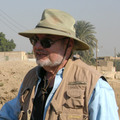
Richard Fazzini joined the museum as Assistant Curator of Egyptian Art in 1969 and served as the Chairman of Egyptian, Classical and Ancient Middle Eastern Art from 1983 until his retirement in June 2006. He is now Curator Emeritus of Egyptian Art, but continues to direct the Brooklyn Museum’s archaeological expedition to the Precinct of the Goddess Mut at South Karnak, a project he initiated in 1976. Richard was responsible for numerous gallery installations and special exhibitions during his 37 years at the museum. An Egyptologist specialized in art history and religious iconography, he has also developed an abiding interest in the West’s ongoing fascination with ancient Egypt, called Egyptomania. Well-published, he has lectured widely in the U.S. and abroad, and served as President of the American Research Center in Egypt, America’s foremost professional organization for Egyptologists.

